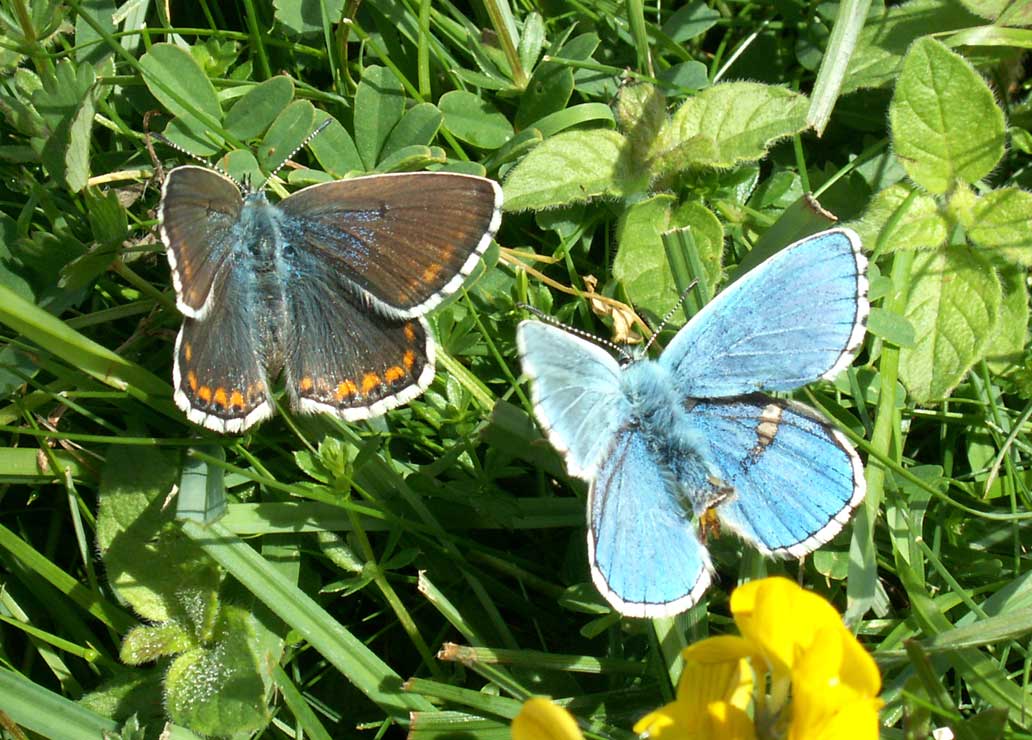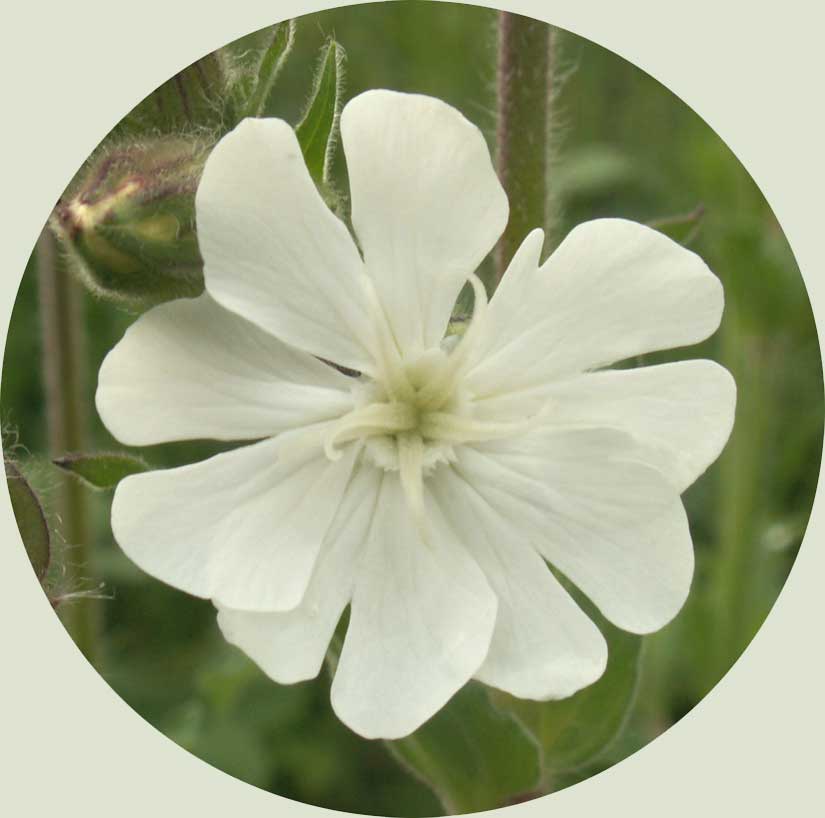-
Wild
Flowers
Addenda
2006
from
May 2006
Wild
Flowers 2007
19
December 2006
A
Scentless
Mayweed on Shoreham Beach (Ferry Road)
was just about in flower with a few petals left.
18
& 20 December 2006
A
Ragwort
was seen as I cycled past without stopping still in flower one the wild
verge by the closed Furnitureland store near the Hamm near central Shoreham,
and the Yarrow
was still just about in flower but had nearly ceased.
17
December 2006
 Hardly
any flowers put on a show during a quick detour up the local downs.
On the Coastal Link Cyclepath south
of the Toll Bridge, Old
Shoreham, I noted Common
Daisies, one
Common Ragwort, one Red
Deadnettle, one
Groundsel and one Prickly
Sow-thistle; on the verges of the the
Waterworks
Road there was just one White Deadnettle
remaining just about in flower and a single Dandelion;
with at least three flowers of Sweet Violet
in a patch on the steep slopes of the southern Mill
Hill, just the one Mouse-eared Hawkweed?
seen on the lower slopes of Mill Hill,
a dimunitive 12 cm Ragwort*
on the Old Erringham pasture, followed by a Small
Scabious on the ridge of Mill Hill. The
count was ten species in about an hour. The frequent flowers of Carline
Thistle on Mill Hill were assumed to be
dead and their leaves were silvery.
Hardly
any flowers put on a show during a quick detour up the local downs.
On the Coastal Link Cyclepath south
of the Toll Bridge, Old
Shoreham, I noted Common
Daisies, one
Common Ragwort, one Red
Deadnettle, one
Groundsel and one Prickly
Sow-thistle; on the verges of the the
Waterworks
Road there was just one White Deadnettle
remaining just about in flower and a single Dandelion;
with at least three flowers of Sweet Violet
in a patch on the steep slopes of the southern Mill
Hill, just the one Mouse-eared Hawkweed?
seen on the lower slopes of Mill Hill,
a dimunitive 12 cm Ragwort*
on the Old Erringham pasture, followed by a Small
Scabious on the ridge of Mill Hill. The
count was ten species in about an hour. The frequent flowers of Carline
Thistle on Mill Hill were assumed to be
dead and their leaves were silvery.
(?
Not
absolutely sure of the the ID: Image.
The
leaves were not be seen. The other possibility is the Autumn
Hawkbit, Leontodon autumnalis) (*
Species not defined and could be Oxford Ragwort?
Later, I thought of the Hoary Ragwort,
Senecio
erucifolius, which was not included in
the first book I looked at.)
Scabious
Seed Heads Comparison Image
 14
December 2006
14
December 2006
Wild
flowers were scarce and only Common Daisies
and Yarrow
were noted.
13
December 2006
Ragwort
was
in flower on the Coastal Link Cyclepath
south of the Toll Bridge, Old
Shoreham. I have not worked out the species.
It has always assumed to be the Common
Ragwort, Senecio jacobaea, and
the 30 cm specimen from the old railway line had brown bracts and appears
to be the common species. The notable green leaved species is the alien
known as the Oxford Ragwort,
Senecio
squalidus.
Ragwort
Facts
Adur
Ragwort
5 December
2006
Yarrow
was still in flower one the wild verge by the closed Furnitureland store
near the Hamm near central Shoreham.
|
 |
1
December 2006
 Under
an overcast sky there were few flowers to be seen on the muddy Coastal
Link Cyclepath north of the Toll Bridge,
Old
Shoreham. The umbellifer on the left was seen
by the first wooden gate on the west side. This is the Common
Hogweed,
Heracleum
sphondylium. By 6 December 2006,
it had almost totally ceased in flower. Because of its small size I thought
it was Angelica at first. Under
an overcast sky there were few flowers to be seen on the muddy Coastal
Link Cyclepath north of the Toll Bridge,
Old
Shoreham. The umbellifer on the left was seen
by the first wooden gate on the west side. This is the Common
Hogweed,
Heracleum
sphondylium. By 6 December 2006,
it had almost totally ceased in flower. Because of its small size I thought
it was Angelica at first.
|
Early
December 2006
White
Deadnettle was seen in flower on the verges
of the Waterworks Road, but whereas it
was common in November,
I only noted one flower.
November
2006

Silver
Ragwort on Southwick Beach
 |
16
November 2006
The
road embankments on both sides of the A27
Mill
Hill Cutting (but more on the north) were shining scarlet red with
the berries of Cotoneaster
and orange-red with the berries of Wayfaring
Tree.
15
November 2006
Tamarisk
was observed in flower by Widewater
Lagoon. |
 |
 1
November 2006
1
November 2006
The
only plant that was as prolific as ever was the Common
Toadflax. However, there were about 30
stragglers remaining in flower past their usual date and too many to list.
These included Thriftby
Widewater
and a second flowering of
Dog Violet
on the lower slopes of Mill
Hill.
Adur
Violets
15
October 2006
 At
the southern dead end of the Coastal Link
Cyclepath by the buffer stop (north of the tunnel of shrubs), I noticed
the a dozen or so dimunitive flowers of Field
Speedwell and one Scarlet
Pimpernel with the more prolific Common
Toadflax. There was at least on Green
Alkanet flower on the verges of the Waterworks
Road (the vegetation was cut down earlier in the year).
At
the southern dead end of the Coastal Link
Cyclepath by the buffer stop (north of the tunnel of shrubs), I noticed
the a dozen or so dimunitive flowers of Field
Speedwell and one Scarlet
Pimpernel with the more prolific Common
Toadflax. There was at least on Green
Alkanet flower on the verges of the Waterworks
Road (the vegetation was cut down earlier in the year).
13
October 2006
At
the extreme southern dead end of the Coastal
Link Cyclepath (south of the tunnel of shrubs) a Silver
Y Moth fluttered amongst the ground vegetation
(mostly now devoid of any flowers but including an occasional Red
Valerian and one Red
Clover).
12
October 2006
The
expected
Devil's Bit Scabious,
Carline
Thistle and a scattering of Autumn
Hawkbits, other plants in flower were
few and far between on the lower slopes
of Mill Hill, but they did include a handful
of blue Common Milkworts, Wild
Basil, Lesser
Centaury, dimunitive Hardheads
and
Self-heal.
The remains of a Small
Scabious and Dandelion
were spotted near the stile to Old Erringham. The Common
Milkworts may have been an unseasonal new
flower rather than a diminished old flower of the other plants. On the
middle patch of Mill Hill there was a Red
Clover. Other plants on Mill Hill and the
Pixie
Path included a few remaining Greater
Knapweed, Agrimony, small
amounts of Ragwort and
Ribbed Melilot.
10
October 2006
 A
few birds flew around the bordering hedgerows and Crows
and
House
Sparrows showed both noisily and visibly
in the late afternoon, but overall, the
cyclepath
north of the Toll Bridge, Old
Shoreham, had an aura of impeding winter with
Smooth
Sow Thistle,
Viper's
Bugloss and Common
Toadflax the common to frequent plants
in flower with the occasional Ox-eye Daisy,
Ragwort, Dandelion, Autumn Hawkbit and
Common
Mallow noted in passing. At least a dozen
plants of Chicory
were in prominent flower on the verges of the Steyning Road (south of the
Cement Works).
A
few birds flew around the bordering hedgerows and Crows
and
House
Sparrows showed both noisily and visibly
in the late afternoon, but overall, the
cyclepath
north of the Toll Bridge, Old
Shoreham, had an aura of impeding winter with
Smooth
Sow Thistle,
Viper's
Bugloss and Common
Toadflax the common to frequent plants
in flower with the occasional Ox-eye Daisy,
Ragwort, Dandelion, Autumn Hawkbit and
Common
Mallow noted in passing. At least a dozen
plants of Chicory
were in prominent flower on the verges of the Steyning Road (south of the
Cement Works).
8 October
2006
Flowers
noted on the Waterworks Road verges were
White
Dead-nettle (common), Scentless
Mayweed, Wild Basil,
Black
Nightshade* Solanum
nigrum, Field Bindweed, Nipplewort,
Field
Speedwell
(second flowering?),
Common
Stork's-bill,
Dandelions
(one
noted in the Butterfly Copse), and
other common species, e.g. one of the
Sow
Thistles, that I did not make a mental
note of as I passed.
Other
species still holding on as isolated flowers on the wasteland were Greater
Knapweed, Creeping Thistle, Common Mallow, Viper's
Bugloss and
Buddleia.
On
the lower slopes of Mill Hill, there were
a handful of both flowering Dog Violets
and Hairy (or Sweet) Violets
were seen in passing and their leaves and sepal colour were both clearly
different. There were a few other flowers for the insects as well, including
Wild
Basil, Yellow
Wort (a surprise flower and a flower rarely
visited by insects and I do not recall a single butterfly visit to this
flower),
the expected
Carline
Thistle and
Autumn
Hawkbit.
Adur
Violets
27
September 2006
On
an overcast day hardly anything moved at all on an afternoon round trip
from Old Shoreham to Botolphs on the Coastal
Link Cyclepath and back via the Coombes Road. There was not much colour
either, the only fresh flowers were the Chicory
on the verges of the Steyning Road (south of the Cement Works) and Common
Toadflax on the verges. Petals were dropping
on many plants, but I still saw intact Herb
Robert on the roadside near Coombes with
the remnants of Red Campion.
The Oak Trees next to the road north of Coombes were sporting acorns.
26
September 2006
I
spotted one autumn Dog Violet on
the
lower slopes of Mill
Hill in the early afternoon. It leaves were noticeable. Devil's
Bit Scabious attracted the butterflies.
Butterfly
Report
20
September 2006
A passage
journey in the sunshine up the incline on the western bank of Lancing
Ring Nature Reserve following the narrow
winding path to the top of Lancing Clump, was uneventful with few wild
flowers including one Harebell
spotted. The Harebell
was facing towards the sun in the southern sky. The meadows were covered
in the young growths of Dogwood
that looked like they could threaten the meadows unless the land is forage
harvested this year. Wild flowers had mostly faded and the only fresh flowers
were of Common Toadflax.
18
September 2006
A
middle of the day trip along the Coastal
Link Cyclepath to
Upper
Beeding was rather a drab with its lack of
flowers, but there were still too many flowers to list: Sow
Thistle, Viper's
Bugloss, a few remaining Fleabane,
Field
Bindweed, Musk Mallow,
Common
Mallow,
Buddleia,
Creeping
Thistles (mostly gone to seed), occasional
Ox-eye
Daisies and
Wild
Parsnip were just a selection of about
fifteen different flowers seen.
17
September 2006
As
the wild flowers were generally dying
out everywhere, I decided to make a note of where the diminished numbers
of butterflies were seen and what nectar
plants if any they were using.
 |
|
|
The lower
slopes of Mill Hill are one of the
only places worth visiting for butterflies
in the middle to late September.
The numbers were less than earlier in the month. 25
Meadow Browns
were counted scattered evenly over the slopes, visiting the common Autumn
Hawkbit, Leontodon autumnalis,
one making a a visit to the occasional Wild
Basil. Then
on the northern part butterflies were all over the place settling on Devil's
Bit Scabious. Other plants noticed in
flower on Mill Hill all in small numbers were Vervain
(in clumps by the paths), Greater Knapweed
(an occasional flower remained), Hardheads
(occasional dimunitive flowers on the lower slopes), Carline
Thistle, Burnet
Saxifrage, one Perforate
St. John's Wort, occasional Agrimony,
a few Lesser Centaury,
clumps of Eyebright,
Squinancywort
and Fairy Flax.
On the middle part of Mill Hill just above the ridge there was a small
amount of Ragwort,
Mouse-eared
Hawkweed (1) and
Bristly
Ox-tongue*(1).
(*
to double-check the ID, could be Prickly Sow
Thistle? ).
15
September 2006
Chicory
was in flower on the road verges south of the Cement Works. However, Fleabane
was fading rapidly and the major clumps of what was a hundred flowers were
down to the last remaining ones and twos.
12
September 2006
The
Rock
Lavender plant was discovered on the gravel
near the pipeline of Widewater Lagoon.
Previously, its nearest location was on the chalk cliffs east of Brighton.
6
September 2006
With
the sun out and the air temperature rose to
24.2 ºC at 1:15
pm, humidity
74%, I just could not stay in so I went for
a small cycle ride after the gales of two days ago.
On
a humid day the first Autumn Gentian
and Autumn Lady's Tresses, Spiranthes
spiralis, (an orchid)
were spotted in flower on the upper part of Mill
Hill (just north of the Reservoir). These are both small plants
that can only be seen in the short sward.

Common
Stork's-bill
Erodium
cicutarium
Waterworks
road verges
|

Autumn
Gentian
|
 |
30
August 2006
Devil's
Bit Scabious was beginning to flower on
the lower slopes of Mill
Hill.
21
August 2006
A
Cat's
Ear was noticed in flower on the Coastal
Link Cyclepath. Chicory
was already wilting on the road verges south of the Cement Works. Viper's
Bugloss was still in flower and is quite
attractive at this time of the year.
14
August 2006
The
inconspicuous flowers of Gypsywortcan
be seen in my front garden in Shoreham.
6 August
2006
4 August
2006
The
yellow flowers of Great Mullein
were just beginning to show on Mill Hill.

|

|

|

|
|
Common
Blue Butterflies on Ragwort
|
Small
hoverfly
on
Field
Bindweed
|
Vervain
|
Common
Blue Butterfly on
Fleabane
|
3 August
2006
The
first flowers of Water Mint have
appeared in my untidy front garden.
2 August
2006
A
Chicory
flower was seen on the western verge of the Steyning Road on the approaches
to the Cement Works from the south. This is a normal location for this
colourful blue flower. The blue of the Viper's
Bugloss was still to be seen in small
amounts on the verges of the Coastal Link
Cyclepath.
A
brief eight minute
visit to the pastures at the foot of Anchor
Bottom up the south side of hill by the Dacre Gardens entrance, saw
me avoiding the cow pats and wading through hundreds of Scabious
and Stemless Thistle,
even more than a week before.

|

|

|

|
|
Common
Toadflax
|
Melilot
|
Lady's
Bedstraw
Galium
verum
|
Agrimony
|
The
four plants illustrated above were recorded on the chalk verges of the
Coastal
Link Cyclepath.
30
July 2006
Carline
Thistle was about to burst into life on
the
lower
slopes of Mill Hill, with
Dodder
recorded for the first time. Common Toadflax
was
now in flower and Snowberry
was budding on the Slonk Hill Cutting south.
Yarrow
was noticed on Slonk Hill south and the middle and upper parts of Mill
Hill.
There
was an escaped Lavender, Lavandula,
on
Slonk Hill south shown in the first photograph above. And also Golden
Rod,
Solidago.
I suspect it is the Canadian Goldenrod,
which is a garden escape.
The
diminutive (50 mm high) Scabious
was noted as usual on the lower
slopes of Mill Hill.
I assume that this is the Small Scabious,
but there were no leaves seen and I do not know to confirm this.
Adur
Dodder
23
July 2006
It
was cooler. Stemless Thistle
was noted as very frequent and Round-headed
Rampion, Field Scabious, Greater
Knapweeds, Yarrow etc.
on Mill Hill.
 |

|

|
|
Musk
Mallow
|
Water
Dropwort
|
Common
Mallow
|
Prickly
Lettuce was in flower with its yellow
flowers and inconspicuous drab appearance of this common (usually an unwanted
weed) that looks like many other flowers of the abundant Sow
Thistle group. Fleabane
was now plentiful and very common. Musk
Mallow was flowering in a field next to
Miller's
Stream, on the west side of the Steyning Road.
Adur
Thistles
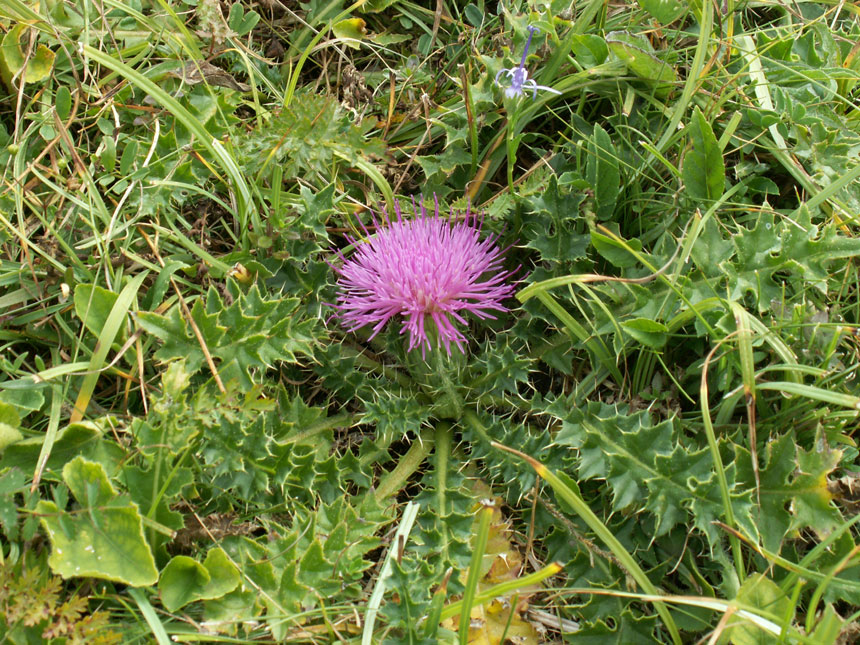
|
 |

|
|
Stemless
Thistle
|
?
|
Round-headed
Rampion
|
14
July 2006
Hollyhocks
was
added to list of flowering plants on the
Coastal
Link Cyclepath verges north of the lay-by and south of the Cement Works.
Also one of the Water Dropworts
(an umbellifer) in the stream next to the Saltings
Field, north-west of Botolphs. Additional Fleabane
was flowering. More Broad-leaved Everlasting-pea,
Lathyrus
latifolius, was discovered near Upper
Beeding.
Adur
Levels
13
July 2006
A
quick look at Shoreham beach seemed to show a reduction in the numbers
of Childing Pink
flowers as somebody had cut the vegetation on the sand outside the Harbour
Club, and only one of the frequent flowers blowing in the breeze was doubled. |
 |
12 July
2006
The
Coastal
Link Cyclepath verges contained meadow flowers and Greater
Knapweed, Lesser Knapweed, (=Hardheads), Rosebay
Willowherb, Creeping
Thistle, Lady's
Bedstraw, Ox-eyed
Daisies and
Perforate
St. John's Wort were all very common to abundant
(ACFOR)
with
Ragwort
very frequent, Teasel, Greater Willowherb
and
Common Mallow frequent, Bristly
Ox-tongue,
Viper's
Bugloss, 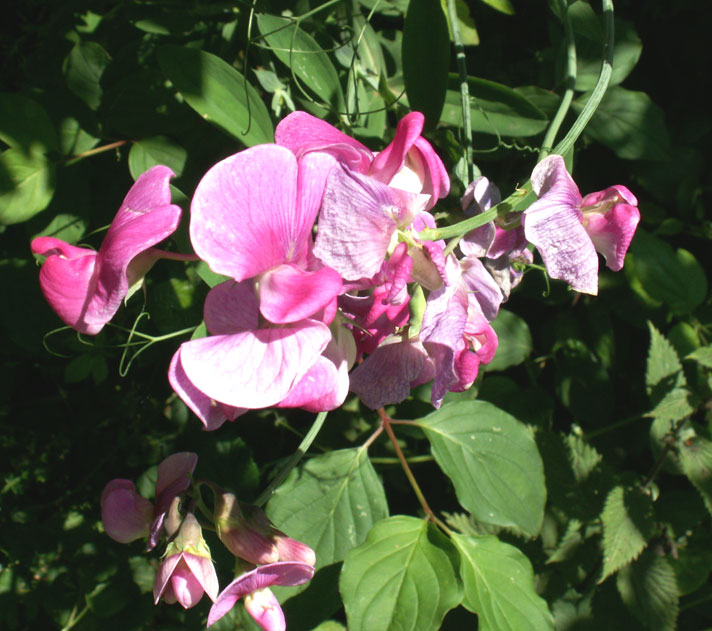 Field
Scabious and Wild
Marjoram just occasional and Fleabaneonly
just coming into flower. Vervain was
noted in flower for the first time, but it it is likely to have been overlooked
before. Green Alkanet was
still in flower on the verges of the Waterworks
Road. Field Bindweed
was all over some fields. This list is not comprehensive as I was not in
the mood to make written notes at the time. Broad-leaved
Everlasting-pea was recorded from the
verges of the Coastal Link Cyclepath. This can be an invasive fast producing
species.
Field
Scabious and Wild
Marjoram just occasional and Fleabaneonly
just coming into flower. Vervain was
noted in flower for the first time, but it it is likely to have been overlooked
before. Green Alkanet was
still in flower on the verges of the Waterworks
Road. Field Bindweed
was all over some fields. This list is not comprehensive as I was not in
the mood to make written notes at the time. Broad-leaved
Everlasting-pea was recorded from the
verges of the Coastal Link Cyclepath. This can be an invasive fast producing
species.
11
July 2006
On
a day of weak sunshine, the following plants were noted in flowers for
the first time: Trailing Bellflower,
Campanula
porscharskayana, (Slonk Hill south), Common
Toadflax and Teasel
(widespread),
Wild Basil (Pixie
Path and Mill Hill lower
slopes) and
Round-headed
Rampion and Stemless
Thistle (Mill Hill).
 |
|
Oil
Seed Rape
Adjacent
to the path near the Reservoir, Mill Hill
This
and related crop plants (Turnip Rape)
seed on the downs and on the Adur
Levels. The cultivated fields have lost their flowers and gone to the
valuable seed. This plant is over 900 metres from the nearest Oil
Seed Rape field. |
|
9 July
2006
For
most of the day a Strong Breeze (Force
6) was gusting to Gales, Fleabane,
the umbellifer Yarrow
and Spear Thistle
were first noted in flower (on the Coastal
Link Cyclepath, south of the Toll
Bridge), with Buddleia (which
probably had been in flower for a few days or weeks) and the usuals like
Ragwort,
Creeping
Thistle, Perforate St. John's Wort, Common
Mallow,
Viper's
Bugloss,
Rosebay
Willowherb, Greater Willowherb, Ox-eye
Daisy, Scentless Mayweed (Frampton's Field),
Wild
Carrot, etc.
Adur
Thistles

|

|

|

|
|
Spear
Thistle on the Coastal
Link Cyclepath
|
Lesser
Burdock has huge leaves at its base, but
smaller leaves near the flowers
|
Evening
Primrose was
in flower
on
Kingston
Beach
|
A
Creeping
Jenny appeared at the edge of the
small pond in my garden.
|
7 July
2006
On
an overcast
day, Stinging Nettles were
flowering. They had probably been flowering for at least a month, but now
were beginning to be noticed.
6 July
2006
Evening
Primrose was
in flower on Kingston Beach.
29
June 2006
Lesser
Burdock was just beginning to flower on
the verges of the Waterworks Road. Also,
the miniature crimson flowers of Wild
Carrot were seen on one out of the thirty
umbellifer heads that were briefly examined.
28
June 2006
Hundreds
of Scentless Mayweed
flowers bordered the path on New Monks Farm
where the Oil Seed Rape
was planted last year and this year the field has just been left.
24
June 2006
In
the weekend sunshine the following plants were noted in flower for the
first time on Shoreham Beach (although they
would have been in flower for at least a week); Childing
Pink, Petrorhagia
nanteuilii, only single flowers so
far, on Silver Sands,
and Tree Mallow,
Silver
Ragwort and White
Stonecrop just to the west of the Old
Fort.
23
June 2006
 |
 |
 |
 |
|
Alfalfa
or Lucerne,
Medicago
sativa
|
Lucerne
|
Tufted
Vetch
|
Common
Centaury
|
 New
flowering plants and scrubs noticed included Hardheads
(Lesser Knapweed) on the Coastal
Link north of the Toll Bridge,
Lady's
Bedstraw,
Lesser
Centaury and Tufted
Vetch on the Slonk
Hill Cutting and Mill Hill, just one
Meadow's
Cranesbill on a long grass meadow on upper
Mill Hill, Great Willow-herb, Bittersweet
and
Creeping
Thistle south of the reservoir on Mill
Hill, and Alfalfa (=Lucerne),
Medicago
sativa,
on the Slonk Hill Cutting.
New
flowering plants and scrubs noticed included Hardheads
(Lesser Knapweed) on the Coastal
Link north of the Toll Bridge,
Lady's
Bedstraw,
Lesser
Centaury and Tufted
Vetch on the Slonk
Hill Cutting and Mill Hill, just one
Meadow's
Cranesbill on a long grass meadow on upper
Mill Hill, Great Willow-herb, Bittersweet
and
Creeping
Thistle south of the reservoir on Mill
Hill, and Alfalfa (=Lucerne),
Medicago
sativa,
on the Slonk Hill Cutting.
20
June 2006
New
flowering plants and scrubs noticed included Elderberry,
Agrimony,
Restharrow,
Self-heal,
Yellow
Rattle (Slonk Hill Cutting), Meadow
Vetchling,
Musk
Thistle (Mill Hill),
Squinancywort
(lower slopes of Mill
Hill), Privet (Mill Hill), Honeysuckle
(garden escapes?) and others missed or not yet identified. These observations
were on the Slonk Hill Cutting and Mill Hill.
The
photograph (on the right) was Meadow Vetching,from
a meadow on the upper part of Mill Hill.
The
flowers (photographed above) were from the wildlife meadow-like areas from
the Slonk Hill Cutting south.
Adur
Orchids
15-18
June 2006
 |

A new
plant in flower on the shingle of Kingston Buci
Beach was the unattractive
Bristly
Ox-Tongue, Picris echioides
.
|
 |
The
two plants illustrated above are frequent on wasteland throughout Shoreham.
Navelwort
looked like it was about to flower in the flint wall of St. Julian's Church,
Kington Buci.
Shoreham
Town & Gardens
Epiliths
 |
15
June 2006
The
photograph may not be good enough for an identification, but I have pencilled
this wild plant in as Nipplewort, Lapsana
communis, from the copse
in partial shade at the top of Mill Hill.
Nipplewort
was wrong. This was the Smooth Sow-thistle,
Sonchus
oleraceus.
On
18
June 2006, this plant could not be rediscovered.
|
15
June 2006
With
wild flowers bursting into flower everywhere, the highlight was about a
hundred
Bee Orchids
amongst the Red Clovers
and Buttercups and
both Hop Trefoil and
Black Medick in Mill Hill Drive, north Shoreham.
Many
of the common and not so common flowers noted like Common
Poppy, Opium
Poppy, and the ubiquitous Field
Bindweed, Bramble
and
Dogwood had probably been flowering for
days, if not weeks. Others like Slender
Thistle (Shoreham
Beach), Greater Knapweed, Eyebright,
Perforate St. John's Wort and
Smooth-leaved Sow-thistle (all Mill
Hill), were possibly less than that and may have begun flowering in
the last day or two. Viper's Bugloss
was noted in splendid flower on
Shoreham Beach.
12
June 2006
On
the Adur Levels and Coastal
Link Cyclepath, new flowers burst into life in the last week including
Common
Mallow,
Biting
Stonecrop, White
Stonecrop (buds only), Red
Valerian,
Dog
Rose, Viper's Bugloss, Creeping
Cinquefoil and
others.
Adur
Stonecrops
11
June 2006
The
following wild plants were seen in flower for the first time this year:
Kidney
Vetch, Yellow Wort, (all
Slonk
Hill north),
Tutsan
(Slonk
Hill south), Dropwort
(lower slopes of Mill
Hill), and Field
Scabious (Mill Hill upper). On
the lower slopes of Mill Hill, dozens of Bird's
Foot Trefoil
were orange in colour.
6
June 2006
On
the flood plain of Widewater
Lagoon where the gravel and pebbles had been disturbed to install the
pipeline, there was a varied collection of plants as though the terrain
had never been disturbed in the first place. Ivy-leaved
Toadflax still dominated but there was
plentiful Sea Kale,
Bird's
Foot Trefoil,
Sea
Campion, Thrift, Sea
Beet, Dandelion, Stonecrops
and
other plants, including a few Yellow-horned
Poppy.
There
were also escaped and naturalised garden plants, some in abundance, but
these white plants were seen on the grass margins north of the bridge.
They were Snow-in-Summer,
Cerastium
tomentosum.
|
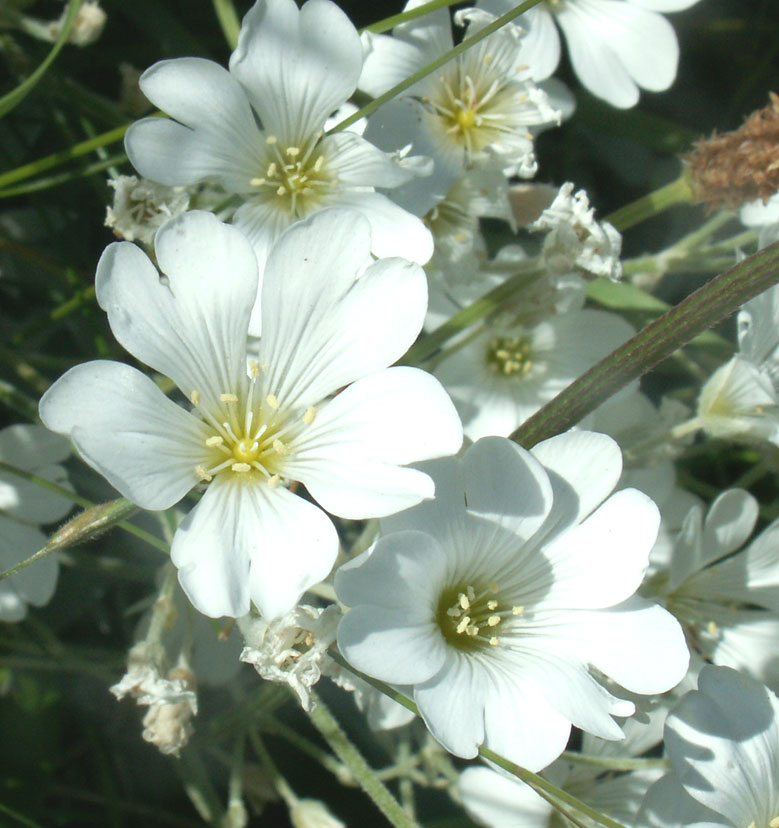 |
4
June 2006
On
the southern bank of the Slonk Hill Cutting
both Common Spotted Orchids and
Pyramidal
Orchids were beginning to flower.
A
quarter transect stroll in the late morning sunshine saw the signs of diminishing
Horseshoe
Vetch on the lower
slopes of Mill Hill to something like
70% of their peak. Yellow Wort leaves
had
pushed up but were not flowering yet, with the first signs of Dropwort,
Hairy
Violet in flower and the beginnings of
Wild
Thyme, more in the Old Erringham pasture
than on the Shoreham Bank. Milkwort
and Fairy Flax were
seen more often.
Adur
Violets

By the
Steyning Road, north Shoreham at the entrance to the Maple Spinney towards
the Waterworks Road, a dozen flowers
of the scarlet Grass Vetchling
were seen.
Yellow
Flag Iris was flowering in Miller's Streeam
and on Spring Dyke next to it.
On
the Coastal Link Cyclepath, Ox-eye
Daisies, Bird's
Foot Trefoil, one or two Common
Spotted Orchids, Red and
White
Campions and other plants including Sainfoin
were
flowering. A single Water Crowfoot
flower was seen in a stream south of the Cement Works and just off (west
of) the path.
2 June
2006
Wood Avens or
Herb
Bennet
29
May 2006
On
the southern grass embankment of Slonk Hill
the first handful of Spotted Orchids
were flowering, but there were scores, probably hundreds, where the spotted
leaves could be seen, but the flowers had not appeared yet. On the northern
bank, the clumps of Horseshoe Vetch
were mostly in flower, with common (300+) flowering Mouse-eared
Hawkweed with frequent Sow
Thistles and patches of the small ground-hugging
Scarlet
Pimpernel.
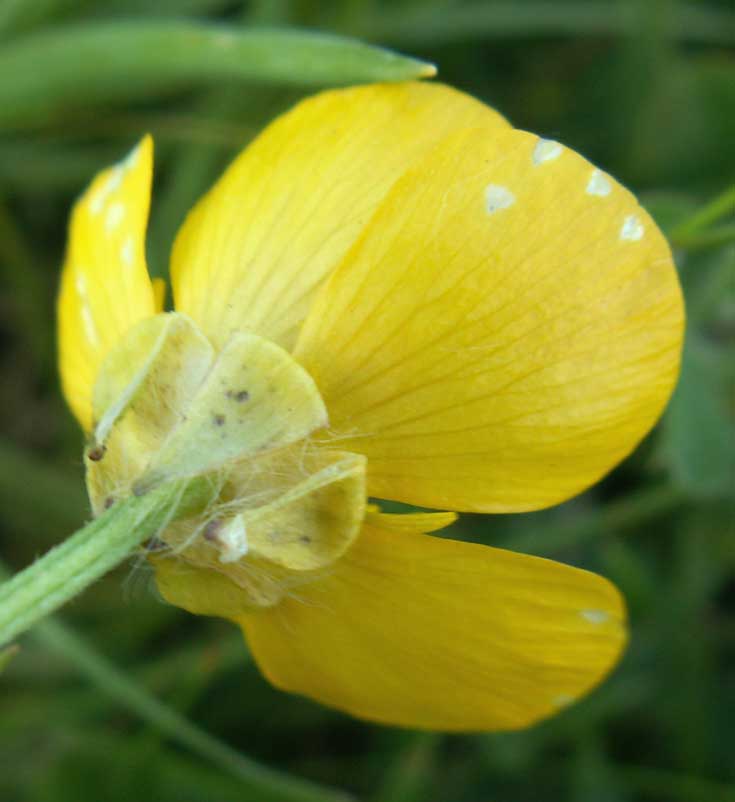 One
of the most dramatic wild flower events was the explosion of Bulbous
Buttercups on the pasture south-east of
Old
Erringham Farm and adjacent to the Mill
Hill Nature Reserve. These buttercups
are always superabundant in this field, but this year they seem to cover
almost the entire area. They even rival the Horseshoe
Vetch, Hippocrepis comosa,
on Mill Hill from a distance.
One
of the most dramatic wild flower events was the explosion of Bulbous
Buttercups on the pasture south-east of
Old
Erringham Farm and adjacent to the Mill
Hill Nature Reserve. These buttercups
are always superabundant in this field, but this year they seem to cover
almost the entire area. They even rival the Horseshoe
Vetch, Hippocrepis comosa,
on Mill Hill from a distance.
Adur
Buttercups
28
May 2006
| The
Horseshoe
Vetch was prevalent on the lower slopes
of Mill Hill, at about 70% of its luxuriance.
Some flowers had not yet opened and it has appeared at the northern end
which it usually does first and has not yet covering much of the steeper
banks, which are always at least a week later. Over a dozen Honey
Bees were attracted to the Horseshoe Vetch.
The Horseshoe Vetch was flowering late compared to 2003, 2004 and 2005. |
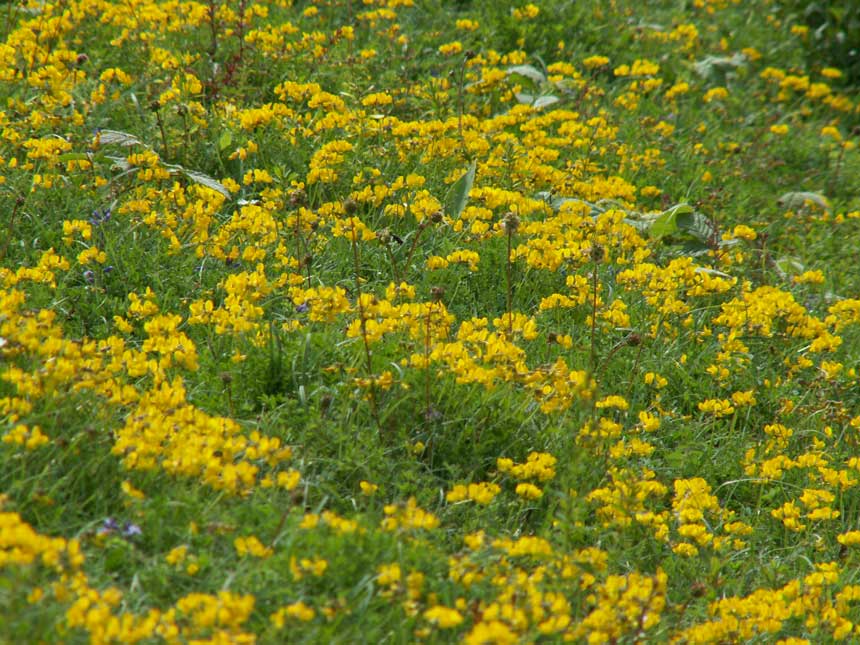 |
 |
26
May 2006
Ox-eye
Daisies, and Red
and White Campion
were beginning to flower on the verges of the Coastal
Link Cyclepath north of the Toll Bridge.
25
May 2006
A
brief visit to Buckingham Cutting (both sides
of the A27) revealed
Milkwort
and Horseshoe Vetch
amongst the continental Salad Burnet
and occasional Bird's Foot Trefoil
on the north side, and on the southern side plants noted in flower included
Ground
Ivy,
Bulbous
Buttercups, Ragwort,
Bluebells,
Red
Clover, White
Campion, Common Vetch and
a few others.
23
May 2006
Lots
of plants coming into flower now: too many to name including Sea
Kale.
16
May 2006
I
went to look for the Starry Clover
on Shoreham Beach near the Old Fort, but
I could not find any. There was some trefoil, probably Hop Trefoil or Black
Medick? Thrift
was in flower and Dove's Foot Cranesbill
and Mouse-ear
and other small plants, and a single Viper's
Bugloss was seen on the edge of an Old
Fort Road roundabout.

|

|
 |
|
I
think that the small marks*
on some of the leaves indicate Black Medick,
rather than Hop Trefoil
|
Bulbous
Buttercup
This
particular flower seems to have a double layer of petals
Adur
Buttercups
|
Thrift
with a tiny fly
|
*The
definitive small point on the blunt end of the leaflets on Black
Medick is difficult to observe in this small
common and widespread plant.
15
May 2006
Silverweed
was flowering on Mill Hill.
14
May 2006
At
least one Bird's Foot Trefoil
was noted in flower next to the winding path on the lower
slopes of Mill Hill. White
Campion was flowering on a horse pasture
on the Mill Hill Nature Reserve side next
to the southern car park.
11
May 2006
Wood
Avens (=Herb Bennet), Geum urbanum,
was
noted just beginning to flower. Ths dainty weed has a yellow five-petalled
flower.
10
May 2006
Germander
Speedwell (not Field
Speedwell) and probably overlooked before
the date.
 |

Common
Vetch
|
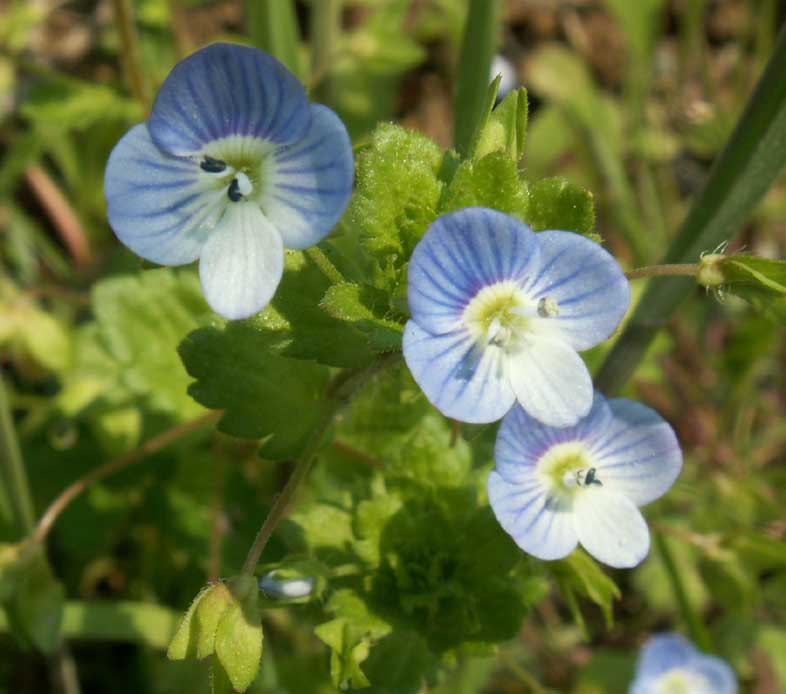
Field
Speedwell
|

Germander
Speedwell
|
|

Over
a hundred Green-winged Orchids
were scattered in isolation over the southern (north-facing) slopes of
Anchor
Bottom (north of the Cement Works). It was difficult to ascertain their
numbers because the extent of their spread was not ascertained. There seemed
to be several hundred.
Adur
Orchids
7 May
2006
Chickweed
was noted in flower on the Pixie Path.
4 May
2006
Common
Vetch was seen for the first time this
year on the southern path of the Slonk Hill Cutting,
with Barren Strawberry (? species,
could be Wild Strawberry
or an escaped Cultivated Strawberry
?).
3 May
2006
The
first Garlic Mustard
was flowering on the Waterworks Road.
Bulbous
Buttercup was now coming out.
28
April 2006
The
first Oxford Ragwort of
the year in Shoreham was seen in flower actually
growing on the Footbridge
from cracks in the structure at the southern end.
18
April 2006
Greater
Periwinkle were in flower in Mill Hill
Road and on verges elsewhere and have been in flower for some time. This
may be more of a naturalised garden plant than wild.
Flora
of Shoreham-by-Sea (List)
Parts
of a Flower
Pollination
Power
Before
May
2006, the first flowers are scattered over
all of the pages.
Flora
of Shoreham-by-Sea
 Hardly
any flowers put on a show during a quick detour up the local downs.
On the Coastal Link Cyclepath south
of the Toll Bridge, Old
Shoreham, I noted Common
Daisies, one
Common Ragwort, one Red
Deadnettle, one
Groundsel and one Prickly
Sow-thistle; on the verges of the the
Waterworks
Road there was just one White Deadnettle
remaining just about in flower and a single Dandelion;
with at least three flowers of Sweet Violet
in a patch on the steep slopes of the southern Mill
Hill, just the one Mouse-eared Hawkweed?
seen on the lower slopes of Mill Hill,
a dimunitive 12 cm Ragwort*
on the Old Erringham pasture, followed by a Small
Scabious on the ridge of Mill Hill. The
count was ten species in about an hour. The frequent flowers of Carline
Thistle on Mill Hill were assumed to be
dead and their leaves were silvery.
Hardly
any flowers put on a show during a quick detour up the local downs.
On the Coastal Link Cyclepath south
of the Toll Bridge, Old
Shoreham, I noted Common
Daisies, one
Common Ragwort, one Red
Deadnettle, one
Groundsel and one Prickly
Sow-thistle; on the verges of the the
Waterworks
Road there was just one White Deadnettle
remaining just about in flower and a single Dandelion;
with at least three flowers of Sweet Violet
in a patch on the steep slopes of the southern Mill
Hill, just the one Mouse-eared Hawkweed?
seen on the lower slopes of Mill Hill,
a dimunitive 12 cm Ragwort*
on the Old Erringham pasture, followed by a Small
Scabious on the ridge of Mill Hill. The
count was ten species in about an hour. The frequent flowers of Carline
Thistle on Mill Hill were assumed to be
dead and their leaves were silvery.
 14
December 2006
14
December 2006












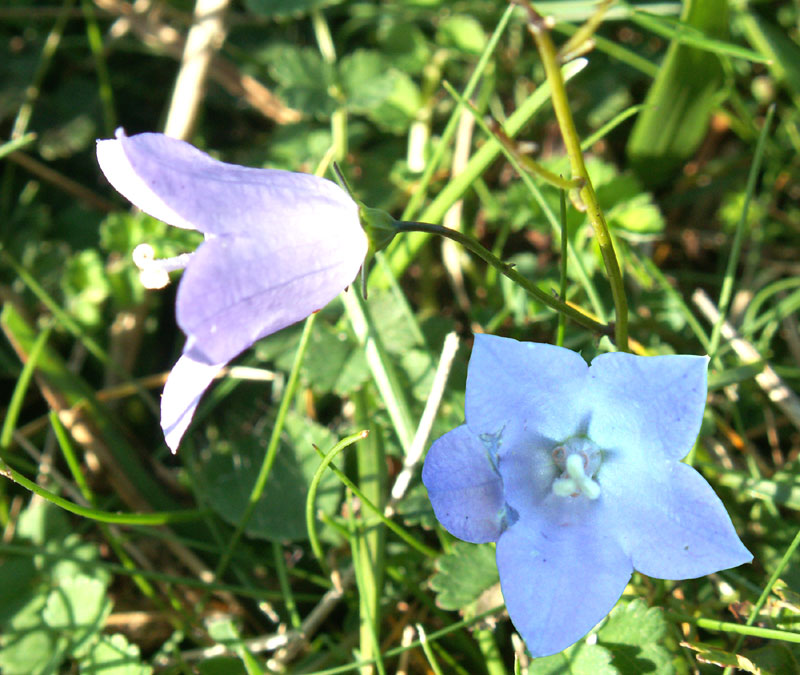

























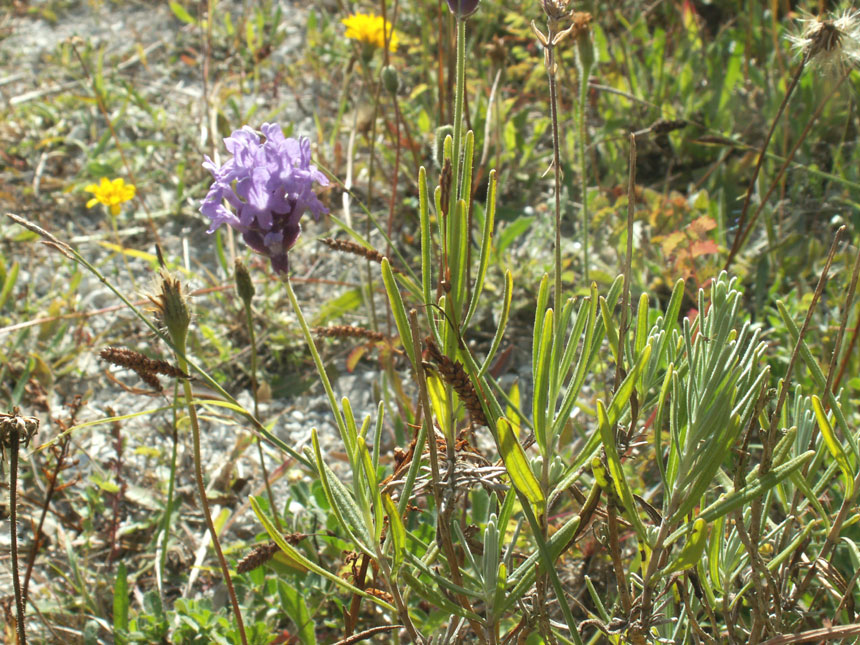

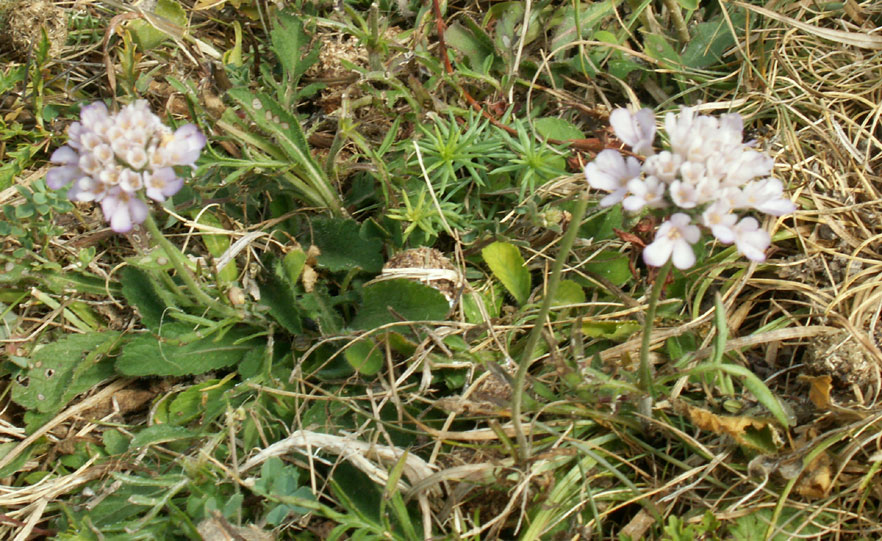







 Field
Scabious and Wild
Marjoram just occasional and Fleabaneonly
just coming into flower. Vervain was
noted in flower for the first time, but it it is likely to have been overlooked
before. Green Alkanet was
still in flower on the verges of the Waterworks
Road. Field Bindweed
was all over some fields. This list is not comprehensive as I was not in
the mood to make written notes at the time. Broad-leaved
Everlasting-pea was recorded from the
verges of the Coastal Link Cyclepath. This can be an invasive fast producing
species.
Field
Scabious and Wild
Marjoram just occasional and Fleabaneonly
just coming into flower. Vervain was
noted in flower for the first time, but it it is likely to have been overlooked
before. Green Alkanet was
still in flower on the verges of the Waterworks
Road. Field Bindweed
was all over some fields. This list is not comprehensive as I was not in
the mood to make written notes at the time. Broad-leaved
Everlasting-pea was recorded from the
verges of the Coastal Link Cyclepath. This can be an invasive fast producing
species.






























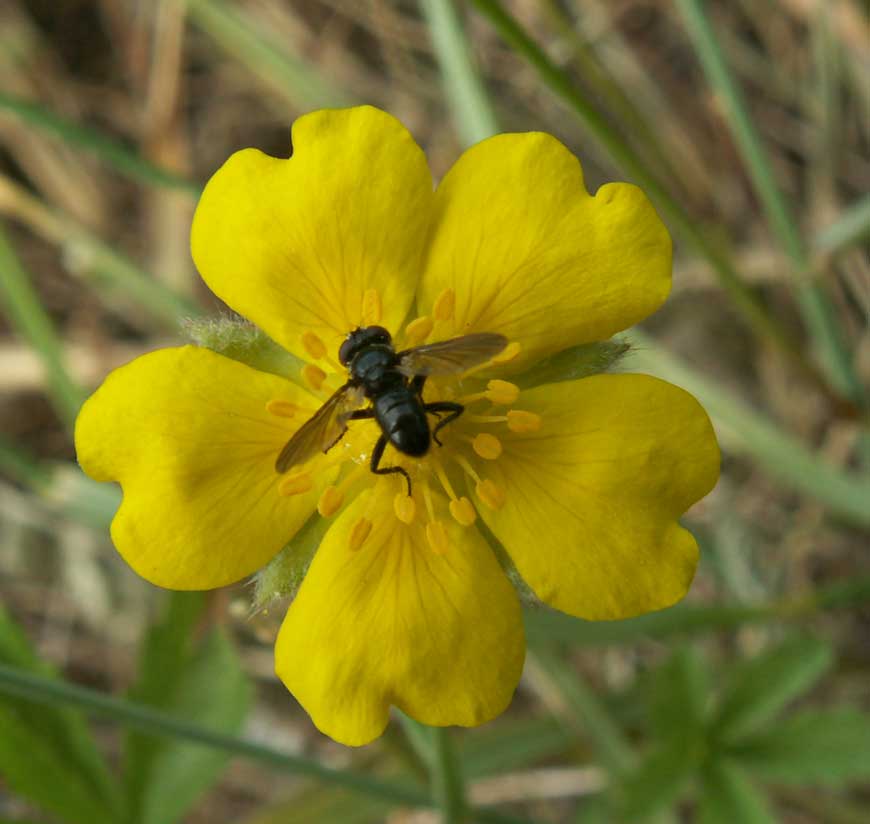





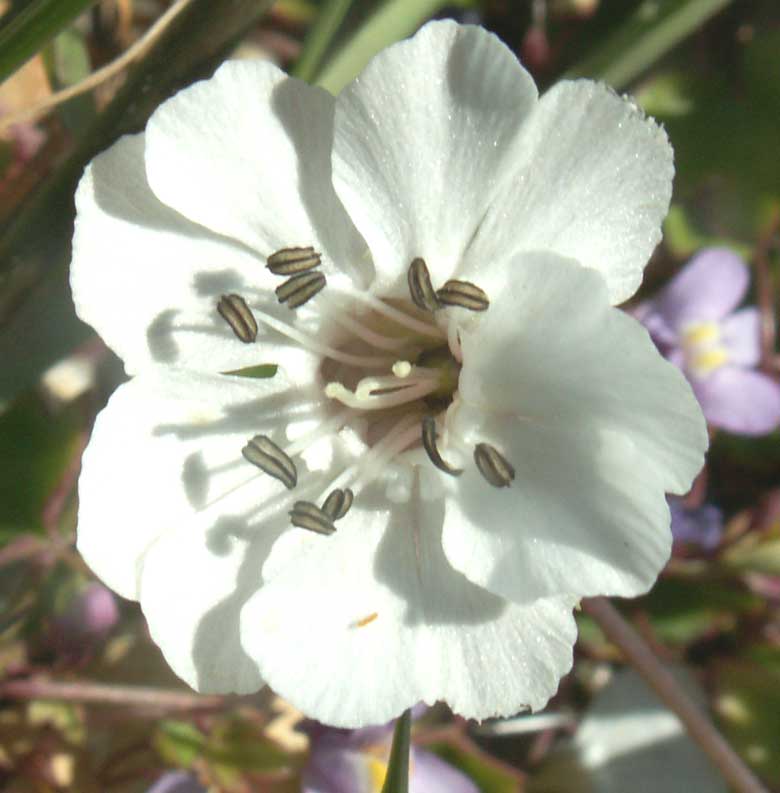






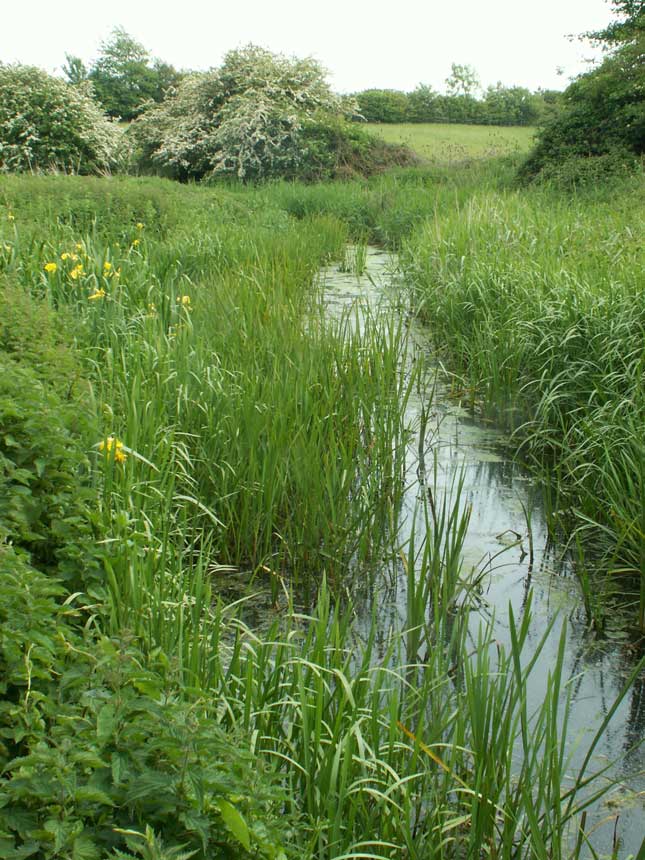





 One
of the most dramatic wild flower events was the explosion of Bulbous
Buttercups on the pasture south-east of
Old
Erringham Farm and adjacent to the Mill
Hill Nature Reserve. These buttercups
are always superabundant in this field, but this year they seem to cover
almost the entire area. They even rival the Horseshoe
Vetch, Hippocrepis comosa,
on Mill Hill from a distance.
One
of the most dramatic wild flower events was the explosion of Bulbous
Buttercups on the pasture south-east of
Old
Erringham Farm and adjacent to the Mill
Hill Nature Reserve. These buttercups
are always superabundant in this field, but this year they seem to cover
almost the entire area. They even rival the Horseshoe
Vetch, Hippocrepis comosa,
on Mill Hill from a distance.


